Mladen and Del review ‘The Tomorrow War’
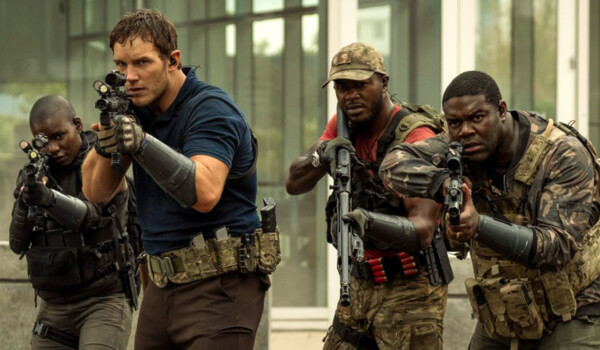
Image courtesy of Amazon Studios.
“The Tomorrow War” Starring Chris Pratt, Yvonne Strahovski, Sam Richardson, Keith Powers, Betty Gilpin, J.K. Simmons and others. Directed by Chris McKay. Too long (2 hours, 20 minutes). Rated PG-13. Amazon Prime.
Mladen’s take
“The Tomorrow War” would be an A if I could look past its derivative plot, two smulchy scenes (one on a beach and the other amid a ferocious battle with an alien matriarch), it’s PG-13 rating and that it’s a product of juggernaut Amazon, which is more of a threat to Earth than the beasts portrayed in the movie would be.
But, I can’t, so this film gets a B-, though the acting is good and the movie’s pacing decent despite its 3,000-hour run time.
Here’s the plot summary, which Del will correct: An intergalactic pet transporter carrying really mean quadrupeds that remind me of the creature in “Cloverfield” crashes in the past on our planet near the North Pole. Global warming thaws the tentacled critters, which also remind me of the mimics in “The Edge of Tomorrow,” aboard the spacecraft in the future. They proceed to nearly take over the planet after eating all its meaty life, including people. Flash to the present and the future, “Tenet”-like, comes to us via a time travel device because Future Humanity needs Current Humanity to help our species survive. How? By Current Humanity conscripting its people as soldiers to fight with Future Humanity against the carnivorous alien invaders. The now‑soldiers are transported in waves to fight in the Tomorrow War by the time travel machine.
The good thing about “The Tomorrow War” is that the time travel paradoxes created in the film are comprehensible.
The bad thing is that the director uses the time travel to insert a who-cares subplot about our protagonist, Dan Forester played by Chris Pratt, and his family. What’s hard about making a sci-fi action yarn without encumbering it with people relationships? I didn’t like Forester any better because he was frustrated with his life as I am with mine. I didn’t like him any better because he was a father as am I. Just give me a story that focuses on what would come naturally to most of us if animals tried to eat our children (and us). We’d fight until one or the other side wins.
If you like the other movies I mention above and masterpieces such as “Alien,” “Aliens,” and “The Thing,” you’ll enjoy “The Tomorrow War.” But, for a sci-fi guy like me, this movie is just one of many stopgap measures between the good stuff.
I also can’t shake the feeling that “The Tomorrow War” was put together somewhat hastily to make Bezos even more money. I don’t know, maybe he underestimated the cost of flying to the edge of space in his personal rocket and “The Tomorrow War” will help him pay the unexpected bills.

Del’s take
Mladen goes on about how he doesn’t care about people, but he really does. Beneath that so-called shriveled turnip of a heart lies the soul of a man who is not ashamed to messy-sob after hearing Netflix changed the ending of “The Notebook.” So I don’t take anything he says very seriously, especially when he fusses about relationships sullying “The Tomorrow War.”
If you removed the relationships from “The Tomorrow War” you’d be left with something like a documentary about ants in the Amazon. Not much fun there. I’d rather be blowing up spaceships and squabbling with my dad about shaving off that Unabomber beard.
“The Tomorrow War” is a perfectly adequate summer escapist movie, in the spirit of “Independence Day,” “Edge of Tomorrow” (a vastly underrated film) and “Battle: Los Angeles.” It is long on action, short on logic, and more entertaining than its length might suggest. In fact, I was shocked to learn it was 2 hours and 20 minutes. It didn’t feel like a two-hour movie.
Mladen summed the plot and you’ve likely seen much of the movie already through the ads. My advice is to turn off your brain and enjoy the cool special effects. The story offers nothing new, but then the drive-thru at McDonalds is always around the block so “new” is not high on the list of America’s entertainment palate. And Chris Pratt is, in my opinion, a huge miscast … but hey, there’s always another “Guardian of the Galaxy” or “Jurassic Park” to fall back on.
My gripe with Pratt is that he does not, in this time or any other, evoke the brawn and swagger of an action hero. He’s more teddy bear than Terminator, a plump Pillsbury Doughboy with a machine gun.
I’m a fan of J.K. Simmons but his role as Pratt’s father is reduced to an algorithmic cipher, just another piece in the blockbuster puzzle that appears to work but doesn’t. Simmons plays the role with a strange lack of emotion that made me wonder if he too wasn’t giggling about the absurdity of it all.
As the movie explodes and gore-sprays to its predictable conclusion you’re left wondering how much money this thing will put in Jeff Bezos’ pocket. From what I hear it was originally earmarked for theatrical release by Paramount until Uncle Covid and the Pandemics arrived in town, and somehow fell into Amazon’s pocket. At least they didn’t charge extra for Prime clients.
Hey look, the movie’s fine for what it is – two hours of mayhem and a chance for mankind to vent his violence on something other than the environment or himself. Don’t expect anything new or different; it’s as predictable as that glowing menu at the Mickey D’s drive-thru.
I agree with Mladen; the movie is a B-.
Mladen Rudman is a former journalist and technical writer. Del Stone Jr. is a former journalist and author.

Image courtesy of Gravitas Ventures.
“Assimilate” Starring Joel Courtney, Calum Worthy and Andi Matichak. Directed by John Murlowski. 1 hour, 33 minutes. Not rated.
Del’s take
It was a tweet that led me to the Refinery 29 list of 130 best new movies on Netflix, and from that I made my own list because I don’t see myself watching sappy holidays flicks where the man and woman fall in love despite their political differences (The very idea bludgeons my suspension of disbelief).
That’s how I tumbled onto “Assimilate,” which shares a common trait with “Spiderman.” How?
The two are part of an endless cycle of recycling.
How many versions of “Spiderman” will Hollywood make before they finally leave it alone? Same goes for “Invasion of the Body Snatchers,” the 1956 classic about the Red Scare. “Assimilate” is, what, the fourth of fifth iteration of that movie? I’ve lost count.
Far be it from me to criticize – I watched the whole damn thing. But honestly: Hollywood, do you need a new scary sci-fi horror movie idea? I’ve got several available if you can lay off the sequels and re-imaginings and revisions.

“Assimilate” takes place in a small town called Multon, Missouri, which looks pretty nice to me – neat and clean, with lots of well kept homes, sparse traffic and a lack of crime that allows you to leave your doors unlocked at night. And it’s those qualities that make Multon a living hell for Zach (Joel Courtney), Randy (Calum Worthy) and Zach’s crush, Kayla (Andi Matichak).
Zach can’t leave because his father lost the use of his legs in … well, I don’t remember the movie explaining that detail. But Zach must stay to help his mother take care of his dad. Randy can’t leave because he’s a loser. Kayla IS leaving and the threat of her absence might prompt Zach into revealing his decade-long crush on her … but the monsters upend that timetable.
Zach and Randy are passing the summer making a vlog about how boring their town is, which they somehow expect people to watch. The video from their cameras provides footage throughout the movie but we’re not talking found-footage; “Assimilate” is mostly live action, thank God.
Strange things begin to happen in Multon as (a) weird little bugs appear and (b) even stranger, floating spore-like organisms take to the Missouri skies, except only WE can see them. That struck me as odd – why two possible catalysts for the invasion we know is already taking place?
People begin taking on the flat affect of a telemarketer (unless it’s Candi, who calls me at least once a month to discuss how I could improve my credit score) and soon Zach and Randy are asking themselves who can be trusted, especially after Mrs. Henderson evolves from horny sex addict to prudish schoolmarm in a single evening. Kayla joins their ranks after her own father becomes robotic and unearthly.
What follows is the usual “Body Snatchers” process whereby the protagonist(s) try to make others aware of the danger and when that doesn’t work, escape themselves.
I mean, what can I say? It wasn’t awful and I don’t have many gripes – the dual-threat thing, yes. That was unnecessary. Oh, and they kept saying they would rescue Kayla’s little brother from the pod people but leaving him with the pod people. The ending departed from most, but not all of the earlier versions, if that’s a virtue.
Other than that, “Assimilate” was nothing more than a 2019 refresh of a 50-something-year-old classic featuring young actors who might be recognizable to the current generation (Courtney starred in the JJ Abrams movie “Super 8” and Worthy was the goofy sidekick in Disney’s “Austin & Alley”). It broke no new ground, but neither did it salt the earth of its predecessors.
I watched it on Netflix and didn’t hate it, hence a C+ grade.
Stone is a former journalist and author.
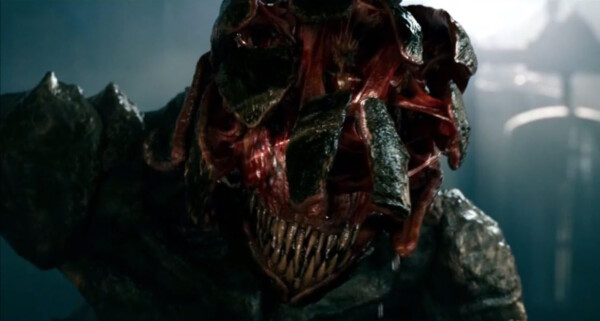
Image courtesy of Paramount.
“A Quiet Place” Starring Emily Blunt, John Krasinski, Millicent Simmonds and Noah Jupe. Directed by John Krasinski. 90 minutes. Rated PG-13.
Del’s take
“A Quiet Place” is relentlessly tense. To be honest, I was relieved when the movie ended because throughout, my stomach was cinched into a knot. It has a couple of problems, but overall it’s a good value for your entertainment dollar and I recommend it.
It’s directed by John Krasinski of “The Office” fame, but Emily Blunt, who plays his wife both on and offscreen, has been getting top billing. Krasinski also directed the film. I’ve always wondered how that works. If you screw up a scene, do you get mad and yell at yourself?
The story is about a family trying to survive the emergence of a blind super predator that hunts by sound. I was a little unclear as to where the predators came from. Are they extraterrestrials? Demons? Genetic mutations? I don’t think the movie made that clear, but reviewers are calling them aliens so I’ll go with that.

The Abbott family lives on an abandoned farm in the countryside, never speaking, never wearing shoes, never doing anything that might reveal their presence to the monsters. They communicate through sign language and scatter sand along their footpaths to muffle the sound of their tread.
The first anecdote of the movie ratchets up the tension to an unbearable level. The family is scavenging for supplies in a nearby town. Their youngest, a little boy named Beau, finds a battery-operated space shuttle toy and wants to play with it, but Krasinski takes it away from him and removes the batteries, explaining the toy is too loud. Later, Beau’s big sister Regan (Simmonds) gives him the toy, and as they’re leaving Beau grabs the batteries.
As they’re walking back to the farmhouse the boy falls behind – because he’s loading the batteries into the toy. When he turns it on it begins to emit loud sounds, and what you fear might happen … well … it actually happens.
Cut to a year later. Blunt is pregnant. Otherwise, nothing has changed. Well, not quite. Regan blames herself for her little brother’s death. She thinks her father hates her. She doesn’t feel welcome in the family, even after her dad tries to invent a turbocharged hearing aid that might repair her deafness. The Abbotts’ other son, Marcus (Jupe), is more terrified of the monsters than the rest of the family and doesn’t think his father will keep them safe. Turns out he should be afraid.
I won’t say anything more about the plot. I don’t want to spoil it for you. Suffice it to say everything that follows cranks up the tension to the point you will be breaking for the bathroom or snack bar just to get your heart back in sync, like I did during a certain scene involving a nail.
But yes, in my opinion the movie had a few problems. The story supposedly takes place between one and two years after the creatures arrive, yet the town the Abbotts raid for supplies looks like it’s been abandoned for many years. By the same token, the farm where they hide is surrounded by lovingly cultivated fields of corn, which could not have been accomplished without the use of heavy – and loud – machinery.
And what’s with this baby thing? Why would they bring a baby into this world? And aren’t babies loud? I mean, really, really loud?
If the monsters are attracted to sound, why couldn’t Krasinsky set up some speakers in the middle of that corn field, crank up the Iggy Pop and blast the monsters to smithereens when they show up?
Details, details.
Apart from those gripes, “A Quiet Place” is a super tense, super scary movie that should appeal to both fans and non-fans of horror. See it in a movie theater. Don’t wait for it to show up on Netflix or Prime.
While I’m at it, let me recommend the smartphone app MoviePass. You pay $7 a month for one theatrical release – per day. Thirty-one movies for $7? I don’t know how they make money at it, but somehow they must.
That’s how we got to see “A Quiet Place.”
I give it a B+.
Del Stone Jr. is a former journalist and author.
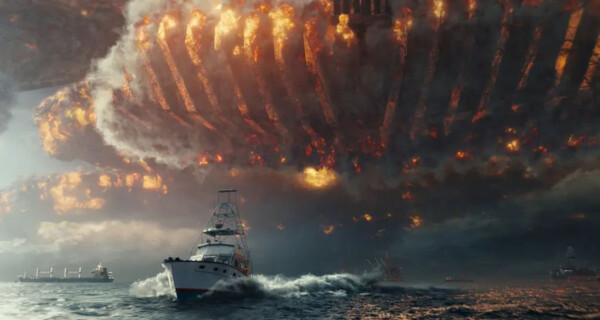
Image courtesy of 20th Century Fox.
“Independence Day: Resurgence” Starring Liam Hemsworth, Jeff Goldblum, Jessie T. Usher, Bill Pullman, and Sela Ward. Directed by Roland Emmerich. 120 minutes. Rated PG-13.
Del’s take
In “Independence Day: Regurgance” everything is bigger and louder and brighter and more menacing that the original “Independence Day.” Alas, everything is not better.
In “Regurgance” as I’m calling it, we get a double-down dose of the original film minus the wit and charm, which is a shame. It could have been a contender for a summer blockbuster. Instead, we’ll have to keep looking and hoping for something a little more filling than whatever mindless Marvel pap we’re served for 2016.
The story takes place 20 years after disrespectful aliens blew up the White House and otherwise embarked on a massive urban renewal project at major American cities, doing a good job of tearing them down but a not so good job of putting them back up. We have finally achieved peace on Earth, thanks to the aliens nearly eradicating us. After the aliens are defeated by Will Smith and Jeff Goldblum we steal their technology and make our own anti-gravity cars and phase plasma rifles in the 40-watt range. The Chinese figure heavily in this renewal and I can safely say “Regurgance” should do well in Beijing and Shanghai thanks to this crude and insulting marketing ploy.
Unfortunately we have underestimated the aliens’ resolve. This time a much larger mother ship arrives carrying an alien queen reminiscent of that “bitch” in “Aliens” who wants to steal our planet’s molten core, turning Earth into a vast wasteland, much like this movie.
Luckily the original crew minus Will Smith, who wisely had died, is back along with a newer, sleeker, younger cadre of heroes who ride to the rescue of good old terra firma. Will they succeed?
Need you ask?
Acting is so-so. Jeff Goldblum is strangely subdued, but dear old dad Judd Hirsch is as unflappable and tart-tongued as ever. Bill Pullman seems confused and maybe a little crazy, and Brent Spiner, who plays a much larger role in this film, is over-the-top kooky and a little hard to digest. The newbies are all cardboard cutouts and about as animated as such, except for sidekick Travis Tope, who shows signs of life despite the horrible lines he’s given to read.
My major gripe with the movie is it lacks the snappy dialogue and sharp wit of the original. It has its funny moments to be sure, but they are sparse and seem to work in spite of, not because of, a diminished script that does not give its actors an opportunity to spread their wings.
Couple that with clichés, a predictable plot, several deus ex machina interventions and a scale of destruction that exceeds the brain’s ability to process what is happening on the screen, and you have, dare I say, a two-hour stretch of cinematic boredom.
If “Independence Day: Regurgance” is your kind of movie then by all means see it at the movie theater, where it’s dazzling visuals are best exploited by the widescreen presentation. But do opt for the matinee when prices are a little lower. I’m not sure it’s worth a prime time movie ticket.
I rate this movie a C+.

Mladen’s take
To cleanse my memory of the worst big-budget movie I’ve seen, I watched the best. Guess which is which: “Independence Day Resurgence/Regurgance” or “The Matrix.”
I’m still worried that I may have nightmares about the nearly $9 I spent to sit for 2 hours to watch another Roland Emmerich bomb.
IDR was mostly terrible. It was boring. It was poorly acted. It was poorly scripted and the graphic portrayal of mayhem overwhelming. If much of the U.S. is wrecked by aliens, then it’ll look like someone had pulverized roads, buildings, airplanes, cars, ships, name it, into pieces from the size of thumbnails to hundreds of feet long and wide and strewn the wreckage everywhere evenly for hundreds of square miles, according to IDR special effects gurus.
What’s worse is that Emmerich suckered many of the first “Independence Day” cast, including Bill Pullman as the former U.S. president who led humanity to its victory against the alien invaders on July 4, 1996, and Jeff Goldblum, the gentle scientist who devised the technology to drop the aliens, to star in IDR. The newbies to the ID universe – yes, there’s another ID on the way unless, I imagine, “Resurgence/Regurgance” fails at the box office (which it might very well do) – aren’t worth mentioning.
Look, I wasn’t expecting high-caliber, intellectual fare from this film. What I was expecting was campy charm, charming characters, quips loaded with defiant charm, and a charming end to the franchise. Instead, the audience was exposed to silly subplots, wimpy weaponry, and an overdose of graphic mis-artistry.
The part of the movie that I enjoyed most lasted, maybe, a cumulative 5 minutes across three or four scenes. It was the crew aboard a salvage ship used to monitor an alien beam that was boring to the center of the Earth from somewhere above the Atlantic. Sound familiar? Yes, the first Star Trek remake with the Romulan mining ship and dreadnaught Narada puncturing a hole in the Pacific to reach Earth’s core to plant a baby black hole that would implode the planet.
Another idea ripped off from other movies by IDR was the configuration and smarts of the alien queen. It/she was a mash of the Alien queen in “Aliens” and the female MUTO in the crappy “Godzilla” of 2014. Why don’t studios sue each other over blatant thefts of ideas, characters, and plots? Lawsuits claiming idea stealing might have two benefits:
- Studios would be forced to create something original
- Audiences would enjoy movie-going once again because they’d be watching something original
Almost forgot, I enjoyed one other part of IDR. No, not when the movie ended, though that was a relief. Emmerich and his zealous graphics developers did a fine job depicting a giant monster (the alien queen) as she moved through a bright, sun-shiny day. It’s often the tendency of moviemakers to show their kaiju amid rain, smoke, or at night. I guess that’s because they don’t have to expend nearly as much computing power (read money) to capture a massive beast’s fine details. In IDR, the alien queen fights mankind in broad daylight and there was a good effort made to depict essentials such as shadows.
IDR was disappointing. I give it a C and that’s generous. This movie failed to deliver what it promised, silliness made entertaining by actors who enjoyed making the movie. I’m coining a new phrase to describe films that are supposed to be summer blockbusters but bust nothing except my happiness. IDR is a summer blockfarter.
Mladen Rudman is a former journalist and technical editor. Del Stone Jr. is a former journalist and author.
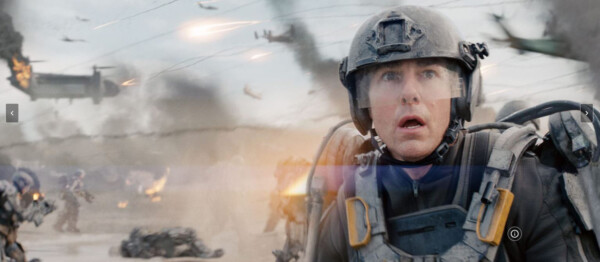
Image courtesy of Warner Brothers.
—
“Edge of Tomorrow” Starring Tom Cruise, Emily Blunt, Bill Paxton. Directed by Doug Liman. 113 minutes. Rated PG-13.
Del’s take
Didn’t Mladen, at some point during one of his hyperbolic rants, swear he’d never see another PG-13-rated movie? Didn’t he say they were all crap?
Well, guess what?
He broke his vow and attended “Edge of Tomorrow,” the latest Tom Cruise sci-fi vehicle, and after the movie was over you should have heard him, squealing like a little girl who’d just been given a peck on the cheek by Justin Bieber. He not only saw another PG-13-rated movie but he loved it.
Mladen, you phony.
His enthusiasm, however, is well-deserved. “Edge of Tomorrow” is a terrific summer movie, carrying the right balance of humor, tension, and spectacle. Your ticket-buying dollars will not have been wasted on this one.
In “Edge of Tomorrow,” an alien race we call “Mimics” has invaded the earth and is swallowing up Europe. Unless they’re stopped, mankind faces the same fate he inflicts on so many animal species of this planet. Cruise’s character, Major William Cage, is sent to the fight despite his credentials as a public information officer for the military. During the battle he kills an “alpha,” a particular kind of alien that, in dying, bestows him with the ability to restart the day each time he dies. (Believe me, there are no groundhogs in this movie, and if there were, they’d all be exterminated.) Through repeating his experiences he’s able to learn and survive a little longer, until he meets up with Sgt. Rita Vrataski (Emily Blunt), who underwent the same experience and learned there’s a very bad alien pulling all the strings. Their mission, which they choose to accept, is to exterminate that alien.
This movie presents so many pluses it’s hard to list them all. The writing is excellent. The dialogue is snappy, at times hilarious, at other times deadly earnest. Pacing, internal logic, respites from tension – they’re all handled with a canniness that speaks to the skills of the writers and the director.
Acting is top notch. Tom Cruise is a sympathetic and realistic character in the bones of the unwilling and frightened Major Cage, and he grows throughout the movie. Emily Blunt is a tough badass who has her vulnerabilities – and might I add it’s a pleasure to see a strong woman in a movie again – and Bill Paxton is funnier than his role in “Aliens.”
Speaking of which, the aliens in “Edge of Tomorrow” are truly alien. I take my hat off to the person who designed them. They look like nothing you’ve seen.
“Edge of Tomorrow” is not “deep,” meaning it won’t be in line for a best picture award. But it’s nice to see Cruise in a winner. It’s nice to see a movie that isn’t based on a sequel or a prequel or a remake of a remake. It’s nice to see a well-written, smart, funny and exciting film again. I was beginning to wonder if I ever would.
I almost clapped at the end of “Edge of Tomorrow,” and if a movie review can make a sound, that’s likely what you hear. Go see the movie. I’d rate it a solid A.
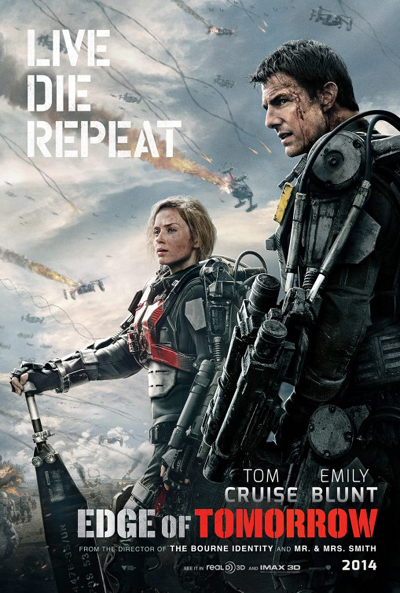
Mladen’s take
It would be easy to dismiss “Edge of Tomorrow” as a trite film because the trailers make it look and sound like “Ground Hog Day” meets “Halo.” But, that would be an error.
Despite its flimsy PG-13 rating, “E of T” is very good. The script and acting – Tom Cruise as Cage and Emily Blunt as Vrataski in the lead roles and Bill Paxton supporting as Farrell – were top notch. Plus, computer-generated graphics were used to enhance the plot, rather than conceal poor writing, silly coincidences that keep a weak story flowing, and crappy, underdeveloped characters typical of summer blockbusters.
Del summed the movie nicely, so I won’t bother. “E of T” is a film worthy of the big screen and big ticket prices moviegoers have to endure these days.
“E of T” is a sci-fi adventure built around its stars. Don’t get me wrong, there’s plenty of gun and grenade play and lots of CV-22-like machines blown out of the sky, but it’s the movie’s characters that keep your attention.
Cage transitions nicely from a selfish and naïve military public affairs propagandist at the beginning of the film to a man clearly thinking about someone other than himself by the end. He dies many times, often in funny ways.
Vrataski is tough from the get-go and the brains behind the operation to whack the Omega, a time-warping brain, that controls the Mimics, hyper-mobile alien troops that have conquered continental Europe.
“Edge of Tomorrow” isn’t perfect, but could have been – yeah, Del, here it comes – if the studio dedicated it to entertainment for adults by going R. Yes, the producers would have made less money, but, in exchange for less change, “E of T” could have gone down in moviedom sci-fi history as masterful. Was “Alien” rated PG(-13)? Was “The Matrix” rated PG(-13)? Was “District 9” rated PG-13? No, no, and no. More realistic battle scenes would have helped “E of T.” Vivid blood spray, graphic skin, muscle, and organ disintegrations after impacts by projectiles or crashes, full-bore cussing, and reproductive urge tension between handsome Cage and beautiful Vrataski would have burnished the movie’s credentials. Instead, we get sterilized deaths and constrained language even when Mimics are running amok and slicing through exoskeleton-equipped human soldiers.
Lukewarm rant aside, I would see “Edge of Tomorrow” again in the theater if I could afford it. And, “E of T” will become part of my Blu-Ray collection when it’s released for home viewing.
Though it troubles me to no end, I completely agree with Del on this one. “Edge of Tomorrow” is a solid A.
Mladen Rudman is a former journalist and technical editor. Del Stone Jr. is a former journalist and author.

Image courtesy of Universal Pictures.
—
“Oblivion” Starring Tom Cruise, Morgan Freeman, Olga Kurylenko, Andrea Riseborough, Melissa Leo. Directed by Joseph Kosinski. 124 minutes. Rated PG.
Del’s take
And why did they choose the title “Oblivion”?
Because that’s how long the movie is.
It’s nice to look at, though. And the cast does a credible job. Critics dismiss Tom Cruise as an actor but he’s good – if you saw “Collateral” you’ll know what I’m talking about. Olga Kurylenko, Andrea Riseborough and Melisso Leo carry their weight, with Leo’s part trending toward Clicheland at the end. Morgan Freeman stars as Morgan Freeman.
“Oblivion’s” problem, however, lies in its veneer of a story. Casual science fiction fans will appreciate its sleek look and original ideas. Everybody else will look at those ideas, recognize they’ve been done time and again, and wonder what the fuss was about.
Here’s the story: Mankind has fought and won a war with alien invaders, but in the process they’ve rendered Earth uninhabitable. Everyone has fled to a sanctuary on Saturn’s moon Titan. Left behind are Jack (Cruise) and Victoria (Riseborough) who must oversee a fleet of drones that protects giant energy harvesters from scattered remnants of the alien invasion force. In two weeks’ time the harvesters will have collected enough energy to ensure mankind’s future on Titan. But a spacecraft crash lands on Earth and disgorges a crew of preserved human beings, including a woman Jack seems to remember from a former life. He begins to question everything he knows, including his current mission.
“Oblivion” relies on a couple of plot twists to deliver impact and I will not reveal them here. Suffice it to say the first act – no doubt intended as a character-building session by director Kosinski – is excruciatingly long and, dare I say, boring. Things pick up in the second act, and it was here I figured out what was really going on in the movie. The third act was mostly action-packed, though a word of warning: If trailers created the impression “Oblivion” is a grand-scale science fiction epic with sprawling CGI battles, think again. It’s mostly character-driven. Movie fans will recognize influences from “2001,” “Minority Report” and “Gattaca.”
Cruise is effective as the memory-wiped Jack struggling for rapprochement with the images he sees of a wife in a former life. Riseborough, his teammate, successfully evokes a slavish dedication to corporate dictates, at one point reminding Jack it’s their job not to remember. And Kurylenko brings to her role a sweetly devoted innocence that makes her worthy of Jack’s attentions.
Leo’s role, as the administrator of an orbiting station that monitors the drones, is constrained, but she nonetheless brings personality to her exchanges with the Earth-side crew until the very end of the movie, when she devolves into a caricature. Freeman has limited screen time and seems to channel Denzel Washington in “The Book of Eli.”
All of this is not to say “Oblivion” is a bad movie. But it’s not very original, it features long stretches of not much happening, and despite its beauty and the skill of its cast, it won’t create a lasting impression.

Mladen’s take
Walking from the theater, I asked Del, “What was the last good movie we saw?” We had just watched “Oblivion.”
“Cloverfield,” was the response after a few moments of thought.
Yet, Del has written a merciful review of “Oblivion.”
To be honest, I sympathize to some degree with his reaction. The actors sincerely and skillful portrayed their characters but were unable to subdue the movie’s weak script, clichéd ideas and too many subplots.
“Oblivion” is a sci-fi dystopian chick-flick fairy tale with some action.
Let’s start with the good.
The cinematography was lush and, somehow, sparing at the same time.
The special effects were very good.
Jack’s bubble engine-powered, high-performing V/STOL aircraft with a goldfish bowl cockpit was neat.
The autonomous spherical drones that protected gigantic water vaporizers were menacing despite their shape. Fast, heavily armed and assessing threats through HAL 9000-like sensor eyes, the unmanned combat aerial vehicles intimidated me not because of their role in the movie. They’re what the real mankind-induced future has in store for us.
Finally, there’s what the orbiting space station administrator would say when she finished giving Jack and Victoria their orders: “Are we an effective team?”
It’s exactly what many of us encounter during the course of a workday. A type of corporate cheerleading that’s all enthusiasm and smiles on the surface and brain-washing dogma beneath that reminds workers they better toe the line if they want to keep their jobs. Are you with us or against us?
Now, a few of the weaknesses of “Oblivion.”
Del mentioned that “Oblivion” has similarities with movies that came before it, “2001: A Space Odyssey,” “Minority Report,” and “Gattaca.” I add “The Matrix,” “Independence Day” and even “Battle: LA” to the list.
Maybe it’s impossible to devise a novel reason that aliens would invade earth. Maybe it’s impossible to end the invasion with other than nuking the mothership from the inside after gaining access to it through implausible deception. But, can’t someone, somewhere try?
“Oblivion” is a complex story. It weaves Jack’s nightmares with suspicions about the truth of his situation. For good measure, there are the battles that he has to fight with “scavs” whenever he has to repair a drone that has crash landed. And, another principal character is fully introduced about half-way into the movie.
Complexity doesn’t have to be bad. The problem is that it can be very tricky to develop as a screenplay. And, in the case of “Oblivion,” it took a long, long time to tie everything together. The effort including introducing a backstory to establish true identities.
As “Oblivion” dragged on, I became bored. Not even the questions that it raised periodically were enough to pull me back from the urge to look at my wristwatch.
I didn’t feel much sympathy for the characters when the movie ended.
And, I was thoroughly irritated by the arrogant dopiness of the lone, star-travelling alien that met its demise by ingesting a human-planted, uncontrolled nuclear chain reaction device. All the being needed was a couple of cloned TSA screeners and an X-ray machine to detect the nuke and it would have been on its way to destroy another planet in just a couple of weeks.
Mladen Rudman is a former journalist and public information officer. Del Stone Jr. is a former journalist and author.
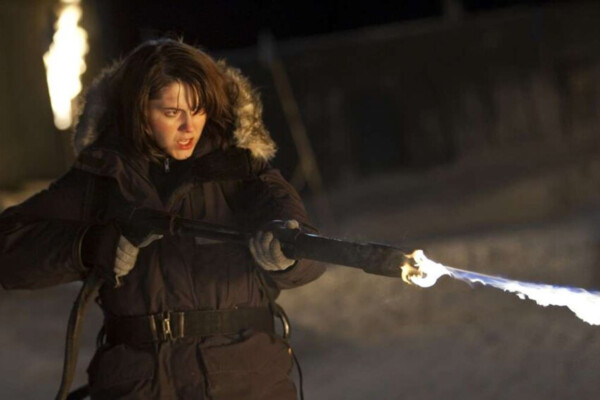
Image courtesy of Universal Pictures.
—
“The Thing” Starring Mary Elizabeth Winstead, Joel Edgerton and Ulrich Thomsen. Directed by Matthijs van Heijningen Jr. 103 minutes. Rated R.
Mladen’s take
Let’s call Director John Carpenter’s 1982 film “The Thing, A.” Let’s call Director Matthijs Van Heijningen’s released-on-Friday movie “The Thing, B.” I do that for two reasons. Those are the grades each movie deserves – actually it’s A+ and B+, respectively. And, it’ll be easier to keep track of which movie I’m referring to because comparisons are inevitable. “The Thing, B” is the prequel to “The Thing, A.”
The “Thing, A” in one of the two finest sci-fi horror movies made. The other is “Alien.”
The formula for success is retained in “The Thing, B.” An isolated group of humans, in this case a multinational research team in the Antarctic. A creature that mercilessly and vividly parasitizes bodies. And, suspense.
My pal Del will probably disagree with the last attribute. Always grumpy and a quibbler, he’d exchange “suspense” for “cheap-shot fear” because there are at least three jump-out-of-your seat moments in “The Thing, B.”
To a degree, I agree with Del.
In the superb “The Thing, A,” the body-snatching, body-cloning alien is portrayed as an amorphous, almost cautious being. It’d prefer to nail you when you’re handy and lashes out only when pursued. That makes the creature scarier because it’s clearly thinking.
In the “The Thing, B,” the alien has a shape of its own. In its original state, the technologically sophisticated arthropod looks like an overgrown wood louse. And, rather than being an ambush predator, like say a praying mantis, it’s an aggressive stalker of anything that moves, like say former U.S. vice president Dick Cheney. That makes the creature more of a monstrosity.
There are implausible moments in the “The Thing, B.” The lead Norwegian scientist ignores American paleontologist Kate Lloyd, portrayed very effectively by Mary Elizabeth Winstead, when she urges that carefully controlled laboratory techniques, including isolation, be used to un-entomb the alien from the ice in which it’s frozen.
Also, the soundtrack used to frame “The Thing, B” is very weak. A day after seeing the film, I’m unable to recall its rhythm or tempo. This is in stark contrast to Ennio Morricone’s foreboding, subtly pulsing, and ingenious score in “The Thing, A.” Sometimes, simple is better. Much, much better.
But, let’s not quibble.
“The Thing, B” takes advantage of the unique elements at its disposal.
Computer-generated graphics are very good and used to enhance the plot, not substitute for it.
Van Heijningen imagines very nicely what would likely happen to a small group of humans confronted by a terrifying fact: If it walks like a human, if it talks like a human, if it behaves like a human, it might not be a human. The scientists act rationally and irrationally as each tries to avoid becoming food for the alien’s DNA. Most notably, as the situation at the Antarctic research outpost deteriorates, the Norwegians and Americans periodically rely on nationality as a source of trust to form us-against-them alliances, though the Thing is uninterested in which flag would hang above its next human victim’s grave. Assuming, of course, there’s anything of the victim’s own remains to recover.
There’s another reason to see “The Thing, B” while it’s in theaters.
Van Heijningen pays tribute, maybe it’s more like deference, to Carpenter’s “The Thing.”
To appreciate the gesture, make sure you’ve seen Carpenter’s film before seeing Heijningen’s and stick around for the credits. Many in the audience started to leave, only to stop, while standing, to watch the end of “The Thing, B.”
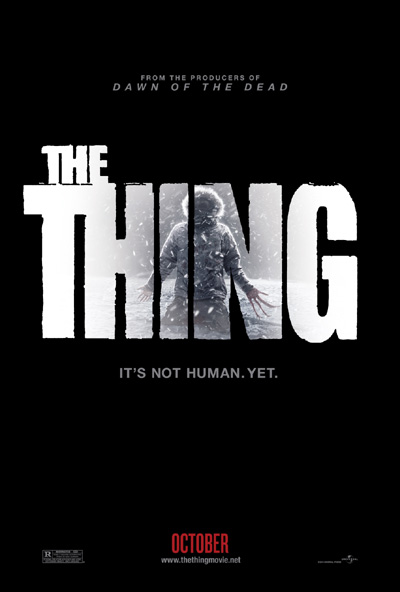
Del’s take
Despite Mladen’s warning that I “expect to be disappointed,” I sat down to watch “The Thing” with a degree of hope and not a few questions:
Billed as a prequel to John Carpenter’s 1982 horror-science fiction classic of the same name, would 2011’s “The Thing” merely replicate its masterful predecessor or bring something new to the story?
Would it scare me intellectually or, like so many “scary” films today, employ a CGI festival of fake gore and monsters jumping out of closets to generate cheap thrills?
How successfully would director Heijningen marry this film to – again – Carpenter’s 1982 horror-science fiction classic? (And I emphasize that Carpenter’s film is a classic despite the scorn of critics and moviegoers of the Reagan era. “The Thing” is a testament to tension done right. Heijningen stands much to lose by treading on such ground, as did the creators of the Keannu Reeves sapfest “The Day the Earth Stood Still”).
First, a word about “The Thing’s” lineage. In 1938 author-editor John W. Campbell wrote a novella for a pulp magazine, Astounding Stories, called “Who Goes There?” about a group of Antarctic explorers who discover a crashed UFO and its pilot frozen into the ice. They accidentally destroy the ship but recover the pilot’s body which, upon thawing, reanimates and begins assimilating the crew, mimicking their appearances and manners. What ensues is the familiar, creepy tale of a small group of human beings struggling for survival against a faceless foe, a story that resonates well with today’s terrorism-infused culture in which the enemy walks among us, unseen.
In 1951 “Who Goes There?” became a movie, “The Thing from Another World,” directed by Christian Nyby (although many consider Howard Hawks the real director). It was loosely based on Campbell’s story but deviated in significant and disappointing ways. In 1982 Carpenter’s iteration more closely followed the plot laid down by Campbell and featured nausea-inducing special effects and a depressing storyline that torpedoed the movie at the box office. Fortunately the movie survived in video, then digital form, to become a cult favorite and, dare I say, a mainstream draw for audiences inured to gory nihilism in moviemaking. Both movies effectively conveyed a building sense of dread that pitted an isolated group of humanity against an invisible enemy – in 1951 it was communism; in 1982 it was ourselves.
Along comes Heijningen’s prequel, which takes up a few days before Carpenter’s movie began. Kate Lloyd is an American anthropologist brought to Antarctica by Dr. Sander Halvorson (Thomsen) to examine a mysterious structure and “specimen” the Norwegians have discovered under the ice. When the specimen is recovered and an ill-advised tissue sample taken, shape-shifting hell breaks loose as the thing goes after the camp crew with the ultimate goal of reaching the larger world, where it can infect everybody.
I have a number of gripes with this “Thing,” some small, some not. The small stuff first:
Score: Marco Beltrami’s score is at best forgettable, at worst an opportunity lost. It conveys little of the tension so effectively embodied by Ennio Morricone’s score for the Carpenter film.
Continuity: As a period piece “The Thing” looks pretty much like a 1982 movie. Computer monitors are correctly hulking and snippets of popular music, from bands like Men at Work, reflect the flavor of the times. But then you have lines of dialogue from, let’s say, a character who’s been told to go and get something and answers, “I’m on it.” That expression wasn’t used in 1982 and I know this because I was around in 1982.
Who’s in charge? In Carpenter’s “The Thing” we knew from the first scene that Kurt Russell was in charge. Even when he wasn’t in charge, he was in charge. In this version Winstead oscillates between leadership and submission. You might think that’s an understandable consequence of a woman being immersed in a 1982-era all-male community, but that’s not what I’m talking about. Authority springs from viewpoint, and authority is not effectively conveyed through Winstead’s character. Sigourney Weaver has proved what an effective female lead can do within an all-male community.
My larger gripes include this iteration’s duplication of the Carpenter movie. At times I thought it was the Carpenter movie. Several scenes seem lifted directly from the earlier film, and the overall structure of “The Thing” copies what Carpenter did in 1982 – with some unfortunate exceptions:
While Carpenter filled his movie with quirky, quixotic characters – almost all of whom were dysfunctionally sympathetic – Heijningen’s prequel features only one person I actually cared about, a lethal deficiency for a horror movie. None of the characters stands out as an individual with a unique personality; they’re all just cardboard cut-outs filling roles as they scream their way down the alien’s gullet.
Worse, this version of “The Thing” does not emulate the brooding, palpable dread Carpenter built into his 1982 film. We are quickly thrown into the fray and forgettable people start dying, stalked by a malevolent force, yet another deviation from Carpenter’s classic. In that film you could almost feel a whiff of sympathy for the creature – it was, after all, a hapless castaway thrust into a hostile environment and was trying to survive the only way it knew how. But now we have a stalking predator that, if it wants to escape to the larger world and propagate, thwarts its own intentions time and again.
On a positive note Heijningen brings his movie to a perfect conclusion, matching it directly to Carpenter’s film. This takes place as the end credits roll so be sure not to leave the theater. It’s actually very cool.
Still, the 2011 “The Thing” has assimilated its earlier classic and produced an inferior copy. On a scale of 1 to 10 I would rate it a 5.
Mladen Rudman is a former journalist and technical editor. Del Stone Jr. is a former journalist and author.
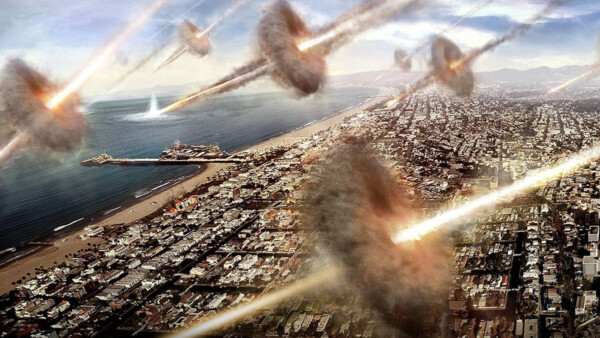
Image courtesy of Columbia Pictures.
—
“Battle: Los Angeles” Starring Aaron Eckhart, Michelle Rodriguez, Bridget Moynahan. Directed by Jonathan Liebesman. 116 minutes. Rated PG-13.
Mladen’s take
Del and I exited the movie theater wondering why the flip no one in the American film industry can produce a good, original product anymore.
“Battle: Los Angeles,” a PG-13–rated sci-fi horror war film, is no exception.
A confession, first, though. I pledged some time ago to never again see a PG-13 movie. They trend toward sucking.
Then, a few weeks ago, I watched “Iron Man 2.” It was an entertaining film, so the PG-13 rating had at least temporarily redeemed itself in my eyes. But, answer one question for me. What happened to Mickey Rourke? No misunderstanding, please. Rourke did a fine job portraying a deranged, avenging Russian physicist in IM2. His appearance worried me, though. The actor’s aged body looked like it was sculpted by Donatello, but his face appeared to be the victim of a botched botox treatment.
Botoxicity might also be the cause of the shape of the heads of the aliens in “Battle for LA.” Their heads look like partially inflated pancakes suspended above elongated arms, legs, and torsos with the sheen of mercury.
“Battle,” Blair Witch Project-like, shadows a Marine squad fighting alien soldiers.
The heavily armed ETs invaded Earth to tap its substantial reserve of water in liquid state. Water is to the aliens what oil is to us, an energy source powering machinery.
“Battle” suffers many terminal flaws, among them:
– Incessant peril interrupted by spasms of unwarranted and unnecessary sentimentality or story backfill.
– Incessant violence that goes undeveloped because of PG-13’s ban on gruesome details in movies with adolescent boys as the target audience.
– An incessantly unoriginal plot, and …
– Incessant duration. “Battle” is 30 minutes too long, assuming it should have been made at all.
The film resurrected itself weakly very late into the story when two alien soldiers appeared aboard a floating gun platform that resembled something dear to my heart, the Wraith of “Halo” video game fame.
In fact, the visual and sound effects in “Battle” are the movie’s only plus.
It was clear that the water-dependent aliens cared nothing about ergonomics or aerodynamics while developing their ordnance and command, control, communication, and computer nodes. The alien arsenal looked primitive, almost gerrymandered, but offered hypersophisticated performance.
The water suckers punctured men, women, and children and toppled buildings with shrieking kinetic energy projectiles or booming chemical explosive warheads, just like mankind will do when it infests outer space. In the fight for LA, there’s no room for sissy laser guns or nukes, which would have contaminated everything.
Unfortunately, there was no room for provocative or consequential storytelling, either.
PG-13 movies are on my crap-list again. I just hope that I learned my lesson this time, once and for all.

Del’s take
Mladen, need I remind you the title of this feature is “Movie Faceoff”? How can we “face off” if we keep agreeing on everything?
To address your question about the American film industry’s inability to produce an original story I would answer: money. If you’re going to spend $70 million on a picture, the reputed budget for “Battle: Los Angeles,” you want assurances you’ll recoup that investment. In “Battle” those assurances amount to: known quantities.
I was expecting much of “Battle.” It would be the next “Dr. Zhivago,” a gritty telling of a society in transition and how the human spirit often transcends larger forces arrayed against it … ahem. Right. What I really expected was a kick-butt alien invasion movie that would hold me on the edge of my seat. For the most part “Battle” delivers on that expectation, but I’m troubled by its flaws, which are numerous and annoying.
The premise of the movie is fascinating – meteor swarms are crashing into the waters off large coastal cities to disgorge invading E.T. armies. The unfolding drama is revealed through televised news clips (though in “Battle’s” world social media don’t play much of a role … do “Battle’s” writers not tweet?). As Los Angeles retreats under the alien onslaught (a scene creepily reminiscent of tsunami footage from Japan) a squad of marines is sent to rescue a group of civilians stranded behind enemy lines.
Visual and sound effects are outstanding. The actors do their best with a script that lurches between predictability and ingenious levity (a Marine is called upon to hotwire a bus. Why him? Because he’s from New Jersey). Pacing is uneven as high-wire action scenes give way to slow, sleepy reflections on the human condition – which is not what I would be doing if alien jarheads were gunning their way into my little corner of the Starbucks fallout shelter.
The problems include what I would call logic flaws – the aliens are nearly impervious to gunfire until our band of brothers catches a live one and discovers its Achilles heel, a kind of heart that, when punctured by a bullet, sends E.T. to his great reward. Suddenly all the Marines – and even civilians – become crack shots and by movie’s end the aliens are falling to the stinkeye.
Also, this business of liquid water is pure and simple nonsense. We’ve known for years water is plentiful in the universe. Several moons in our own solar system are awash with water, both liquid and frozen. And if the aliens prefer their water in a liquid state, could they not grab a hunk of ice and … melt it? Agreed, watching ice melt is no fun. As every evil rancher knows, stealing somebody else’s water is so much more interesting. …
Which leads me to “Battle’s” greatest flaw: Its horrible cliches.
Early on as I struggled with “Battle’s” cinema verite shaky cam footage I decided I was watching “Saving Private Ryan” retold as “Black Hawk Down” with aliens. The visual storytelling technique Ridley Scott used in “Black Hawk” is duplicated here, and the story mirrors Steven Spielberg’s “Ryan” down to the climactic battle against German troops and tanks. In “Battle” we see otherworldly folk lurking on rooftops taking potshots at our squabbling squad, whose members struggle with the questionable leadership of their sergeant. C’mon, guys. “Known quantities” doesn’t mean “ripoff.”
And the ending, which I will not reveal, is just too corny for words.
“Battle: Los Angeles” would make a fine video game but as a movie it falls short in many fatal ways. If I had to rate it on a scale of A to F, I would give it a C-plus.
Save this one for Netflix streaming.
Mladen Rudman is a former journalist and technical editor. Del Stone Jr. is a former journalist and author.
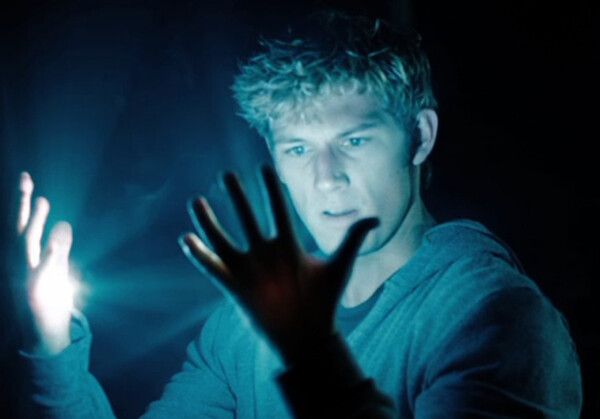
Image courtesy of Touchstone Studios.
—
“I Am Number Four” Starring Alex Pettyfer, Timothy Olyphant and Dianna Agron. Directed by D.J. Caruso. 109 minutes. Rated PG-13.
(Note: Mladen Rudman could not make the screening of “I Am Number Four.”)
Sadly, “I Am Number Four” is not much more than a steaming pile of number two.
Why?
The film suffers from an extreme case of schizophrenia coupled with an identity crisis. Is it a love story? Is it an action movie? Is it “Twilight”? Is it a summer movie?
It is all of these things and consequently none, which leaves “I Am Number Four” hanging in sequel limbo, possibly lost forever to producers Michael Bay and Steven Spielberg who, along with novelist James Frey (writing as Pittacus Lore, upon whose books the movie is based ) clearly aimed to produce the next superhero teen-angst franchise.
The plot is simple … or maybe not. A small group of alien refugees has come to Earth after evil Mogadorians ransacked their world and slaughtered their people. They’re hiding among us, hoping to blend in, as a Mogadorian hit squad roams the world, killing them in order ( hence the title “I Am Number Four” ). Numbers one through three have been eliminated. John ( Pettyfer ) is next. He and his protector, Henri ( Olyphant ) arrive at a small town in Ohio where John enrolls in the local high school. He meets and develops feelings for the retro-chic Sarah ( Agron ); clashes with Sarah’s ex, Mark ( Jake Abel ), who happens to be the high school football team’s quarterback AND the son of the local sheriff; and hooks up with the school nerd, Sam ( Callan McAuliffe ), whose dad mysteriously disappeared while tracking down evidence of extraterrestrials. As the pecking order is sorted out the Mog hit squad arrives, looking very Matrixesque. All hell breaks loose. As hell is resolved and the potential for a sequel clarified, Number Six ( Teresa Palmer ) shows up and lends a gun to the climatic battle.
Is “Number Four” a love story? Well, sort of. Lots of quality time and kissing between John and Sarah, and not a wisp of romance between John and Number Six ( though Sam seems smitten by the blonde bombshell ). Clearly the two have a thing for one another, and Sarah has renounced her relationship with Mark. But – and this is a big “but” ( warning, spoilers follow ) – at the end of the movie John leaves Sarah ( or at least appears to do so … something that could easily be fixed in the next film) and we’re left wondering just how dedicated these two are to each other.
Is “Number Four” an action movie? It is if you stick around for the second half. In the first 30 minutes it’s nothing more than a massive info-dump and scene-setting vehicle. We see Number Three die and John and Henri leave their Florida hideout for the anonymity of Small Town Ohio. We see John go to high school and endure the alleged rituals peculiar to that stage of a person’s life. We get voice-over background about the Mog’s destruction of John’s home planet. Pretty boring stuff. Along about mile marker 34 things get interesting as the Mogs show up and John discovers the true extent of his alien powers ( lightning speed, super strength and flashlight hands! ). Meanwhile we also learn Sam’s dad’s disappearance might have had something to do with the Mogs, which makes him a permanent member of John’s growing retinue, and Number Six is closing in to make sure John doesn’t die ( What the heck is Number Five doing? Playing Farmville? ).
Is “Number Four” “Twilight”? You better believe it. Same target audience, same plot. I wouldn’t be surprised if Sam turns out to be a werewolf.
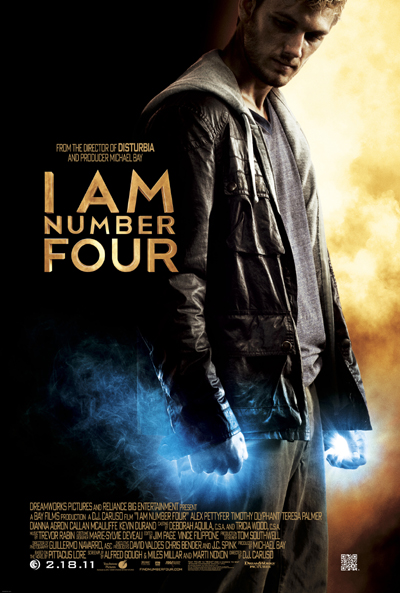
Lastly, is it a summer movie? Let’s put it this way: When the weather is cold I like to open a bottle of Redhook ESB, a hearty ale with a hefty bite that seems to keep the chills at bay. We’re talking “Winter’s Bone” or “The King’s Speech.” Come warmer weather, with its high heat and humidity, I switch to lighter, frothier fare, say a Corona Light. “Number Four” is definitely a Corona Light. It requires no thinking. So why was it released in February?
“I Am Number Four” is shot through with plot holes and logic flaws. No explanation is ever given for the Mogs inimical behavior, or why they must kill the refugees in order. John’s protector, Henri, is easily overcome and kidnapped by a couple of Ohio rednecks. Sarah’s picture-taking hobby seems peculiarly out of touch with the times as she uses ordinary film and develops her own prints. And only fleeting reference is made to why the Mogs must kill the alien refugees – apparently they’re capable of some great power, which begs the question: Why didn’t they use that power when their world was under attack?
Worse, “Number Four” is a cliché machine. Why must every new kid in high school fall in love with the ex-girlfriend of the football team quarterback who is the sheriff’s son? Why is the picked-on, shunned nerd really the smartest kid in school who has hidden strengths but doesn’t show them until a sexy protector arrives? Why must the viewpoint character discover his extraordinary powers while resisting school bullies? And why must every adult in the film be so clueless?
Acting was serviceable. Pettyfer is not a bad-looking fellow and Agron did as much with her role as she could. Better was McAuliffe, and my favorite character in the movie, the Mog commander, played by Kevin Durand, reveled in his evilness.
As of this writing “I Am Number Four” has made about $38 million at the box office. If it clears $100 million a sequel will probably be made.
Don’t hold your breath. The movie dropped 43 percent at the box office in its second week, which is a bad, bad sign. I expect it to top out in the $50 million to $60 million range.
“I Am Number Four” is, in my opinion, a Netflix movie. Save your ticket dollars for “Battle: Los Angeles.”
Del Stone Jr. is a former journalist and author.
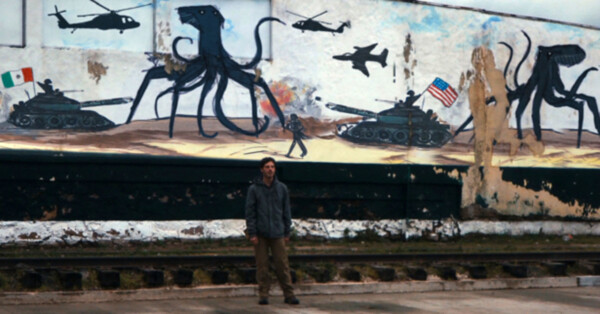
Monsters-movie-image
Image courtesy of Magnet.
—
“Monsters” Starring Scoot McNairy and Whitney Able. Directed by Gareth Edwards. 94 minutes. Rated R.
Del’s take
Late in the movie “Monsters” there comes a moment a literary book reviewer might call “luminous.” Ever notice how literary book reviewers always bring the word “luminous” into play, as if to excuse the lack of plot, the unfolding of dreary characterization and the trendy massacre of clearly wrought prose? You will never hear a Larry Bond novel called “luminous.”
This illuminating moment takes place when our two protagonists, Andrew (Scoot McNairy) and Samantha (Whitney Able), witness two 300-foot tall walking squids engage in making out, foreplay, maybe actual intercourse – with all the flailing tentacles, bioluminescent pulsing and noble whale song-like groaning it’s hard to tell what’s going on. Andrew and Samantha watch in awe as these two leviathans perform the vertical bop and you expect them to whisper, “Beautiful” as they gaze adoringly at each other.
I was whispering “Will somebody please BLOW THESE THINGS UP?”
To paraphrase my friend Kari: “Monsters” is what happens when an indie filmmaker, the cinema equivalent of a literary writer, tells himself, “We have nothing to fear but fear itself … and monsters.”
“Monsters” isn’t about monsters, that’s for sure. The monsters are metaphors for Andrew and Samantha, or illegal immigration, or existential angst. But it is more about the message getting lost in a stew of competing thematic imperatives.
The story goes like this: NASA discovers evidence of life elsewhere in our solar system and dispatches a probe to recover a sample. The probe crashes somewhere in Mexico and shortly thereafter weird creatures begin disrupting the flow of cocaine to America. Andrew, a jaded photojournalist, goes into the “infected zone” to document the mayhem. But he somehow becomes responsible for escorting his publisher’s daughter, who has been in the area, back to the States. They try by land, sea and air but due to a series of setbacks, mostly caused by their own stupidity, they fail and must travel directly through the infected zone to reach the gigantic wall America has constructed along its border with Mexico. Along the way Andrew, who has a kid but not a wife, and Samantha, who is to marry a fellow she doesn’t love, discover a growing affinity for each other. Can you guess how this is going to end?
I will give Edwards credit: “Monsters” is ambitious. It is not another “Godzilla,” “The Mist” or “Cloverfield.” What I didn’t like about it, however, was the plodding pace, the incompetence of the characters and their forced transformations, which did not encourage me to suspend my disbelief.
Characterization is shaky. We are expected to dislike Andrew at first because of his cynicism, then bond to him as he realizes there’s more to life than shooting a prize-winning photo. In reality Andrew is a scummy opportunist who shacks up with prostitutes when Samantha won’t sleep with him, something he pursues with such diligence that Samantha could have had him arrested for sexual harassment. And Samantha, as the poor little rich girl, is a cipher with no real purpose for existence other than serving as an object of desire for Andrew.
At every critical juncture in their journey they pause, undecided, then embark on some irrelevant and unrealistic conflict that jeopardizes their success. For instance, at one point they must get off a boat and travel overland under the watchful eye of armed guards – except Andrew doesn’t want to because the guards are carrying guns. Um, excuse me, but what part of “armed” did he not understand? And in a land occupied by 300 foot-tall squids who like to squash human beings, would you rather your guards be armed with Nerf Frisbees?
And once they reach the wall, well. It’s every Tea Partier’s dream, a cement monolith designed to keep out “illegal aliens.” Except the aliens, as we see in the scene I referenced above, are nothing more than noble, benighted creatures who want nothing more out of life than a brief interlude of happiness amidst an uncaring world. Except they are 300 feet tall and like to squash humans. I say, “Will somebody please BLOW THESE THINGS UP?”
“Monsters” is an interesting movie but it has problems. On a scale of A to F I would rate it a C+.

Mladen’s take
Let’s start with a list.
They’re 300-foot-tall walking octopi, or is it octopuses? Get your mollusks straight, Del.
They do get blown up, you savage, it’s just not witnessed, and,
“Monsters” the movie has one of loveliest, mournfully serene soundtracks ever pasted to celluloid.
For me, the best way to characterize “Monsters” is this: The movie is deeply satisfying, but superficially disappointing.
It took me about 20 minutes to realize that the film was unlike a Godzilla smashfest, “Cloverfield,” or “The Mist.”
After that, I shed the expectation of carnage and allowed the movie to chart its own course. The story is about man’s inhumanity to man and our reckless belief that we can corral nature.
Samantha and Andrew are likable tools used to teach us a lesson. They do a good job leading us through the Infected Zone, where the alien creatures have established a sanctuary after being brought to Earth by a NASA probe that crashed.
Once in the zone, the duo exists to draw attention to the look of civilization as it’s consumed by its own folly.
Vines overtake hotels built for tourists.
An F-15 emerges from the depths of a river, playfully pulled through the black water by one of the tentacled beasts. It never bothers Samantha, Andrew, or the crew of the longboat hired at an exploitative price to help get the Americans back to America.
When the couple finally reaches the U.S.-Mexico border, it discovers that the zigzagging walled fortress separating one country from the other has been abandoned. The aliens had breached its ramparts. The fight has come to the Homeland.
Agreed, there’s some hokey symbolism in “Monsters.” Del already gave examples, but you have to give the director of the film credit for trying to create something original.
“Monsters” is an artsy film with a liberal message, which ain’t gonna play too good in these parts.
Sit back and enjoy the film, paying attention to events and scenes framing the relationship between Samantha and Andrew because that’s the movie’s strength.
Mladen Rudman is a former journalist and technical editor. Del Stone Jr. is a former journalist and author.